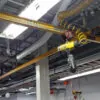Chain and Sling Hoist Workplace Operational Safety
In every business, effective safety procedures and processes ensure employee and customer safety, and should always be a first priority. In this article, we will cover safety precautions, hazards, and guidelines related to chain hoists and lifting slings. We will also address common questions such as safety precautions when using a chain hoist, the hazards associated with chain hoists, safety in lifting slings including basic slinging, and sling safety guidelines.
Chain Hoist Safety Precautions
When using a chain hoist in industrial settings, it's crucial to prioritize safety to prevent accidents and injuries. Here are some essential safety precautions to follow:
Here are some essential safety precautions to follow:
-
- Inspection: Before each use, inspect the chain hoist for any signs of damage or wear. Check the chain, hooks, and other components for cracks, corrosion, or deformities.
- Weight Limits: Always adhere to the manufacturer's recommended weight limits for the hoist. Overloading the hoist can lead to equipment failure and accidents.
- Proper Training: Ensure that operators are properly trained to use the chain hoist. Operating the hoist requires skill and understanding of safety protocols.
- Secure Attachments: Make sure the load is properly attached to the hook and that the hook is securely fastened to the hoist. Improper attachment can lead to load drops.
- Clear Area: Clear the area beneath the hoisted load to prevent anyone from walking or working underneath it.
- Even Load Distribution: Ensure that the load is evenly distributed on the hook. Imbalanced loads can cause the hoist to tip or fail.
- Communication: Maintain clear communication between the operator and any workers involved in the lifting operation. Use signals or radios if needed.
- Avoid Swinging Loads: Prevent swinging of the load, as it can lead to collisions and accidents. Control the lifting and lowering process carefully.
Hazards of Chain Hoists
Chain hoists, while highly efficient, come with potential hazards that need to be recognized and mitigated:
-
- Load Drops: Insufficiently secured loads can detach from the hook, causing damage and endangering workers below.
- Equipment Failure: Overloading the hoist or using damaged equipment can lead to hoist failure, dropping the load unexpectedly.
- Slipping or Snagging: Chains can slip or snag during lifting operations, causing accidents or damaging the load.
- Inadequate Training: Operators without proper training might make errors in operating the hoist, leading to accidents.
- Electrical Hazards: Electric chain hoists pose electrical shock risks if not used or maintained correctly.
Lifting Sling Safety and Basic Slinging
Lifting slings are vital components of material handling. Understanding basic slinging techniques is crucial for safe operations:
-
- Selecting the Right Sling: Choose the appropriate sling material (wire rope, chain, synthetic) based on the load, environment, and lifting method.
- Inspecting Slings: Regularly inspect slings for signs of wear, damage, or deterioration. Replace damaged slings immediately.
- Proper Angles: Maintain proper angles between the sling legs and the load to ensure even weight distribution.
- Securing the Load: Ensure the load is stable and balanced before lifting. Use padding or protective materials to prevent damage to the load and the sling.
- Avoid Sharp Edges: Sharp edges can damage slings. Use edge protectors to prevent cutting or abrasion.
- Sling Protection: Protect slings from chemicals, heat, and other harmful elements that could compromise their strength.
Safety Guidelines for Slings
Following safety guidelines is essential when using lifting slings:
-
- Capacity Limits: Adhere to the manufacturer's weight ratings and capacity limits for the chosen sling.

- Avoid Knots: Knots can significantly weaken slings. Never tie knots in lifting slings.
- Clear Communication: Establish clear communication between the lifting team members to coordinate movements and actions.
- Use Proper Hardware: Ensure that hooks, shackles, and other hardware used with slings are suitable for the task and properly rated.
- No Sling Overloads: Never overload slings or use them in ways they weren't designed for.
- Proper Storage: Store slings in a dry, cool area away from direct sunlight, chemicals, and moisture.
- Capacity Limits: Adhere to the manufacturer's weight ratings and capacity limits for the chosen sling.
Let’s face it. Safety is everyone’s concern both in the work place and at home. Many of these guidelines may seem to be common sense, but too often employees find themselves trying to do too many things at one time or are in hurry to get a project done. These distractions can make employees forget these basic guidelines and can lead to potential property and equipment damage, and worse – employee injuries.
Take time to review these guidelines with your employees and set them up with a safe work environment and processes to follow. For questions about this article or to discuss how Pride Tool can assist with your hoist testing program, visit https://pridetool.com/products/ or contact us at pride@pridetool.com.











